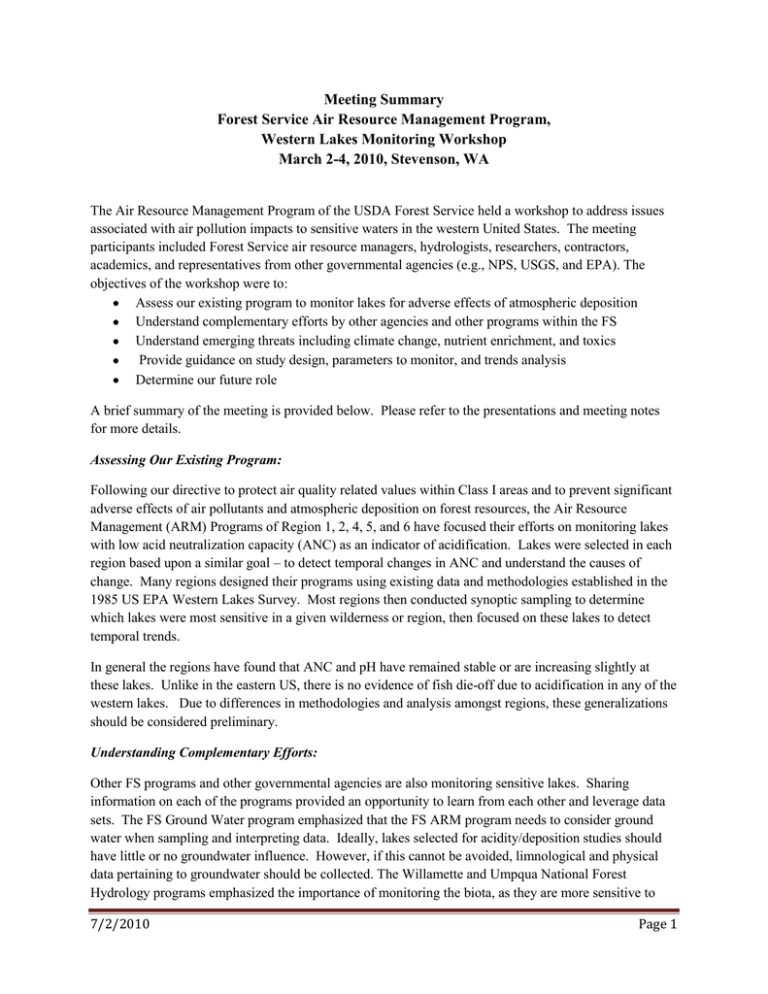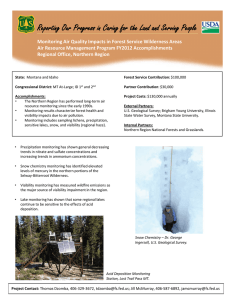Meeting Summary Forest Service Air Resource Management Program, Western Lakes Monitoring Workshop
advertisement

Meeting Summary Forest Service Air Resource Management Program, Western Lakes Monitoring Workshop March 2-4, 2010, Stevenson, WA The Air Resource Management Program of the USDA Forest Service held a workshop to address issues associated with air pollution impacts to sensitive waters in the western United States. The meeting participants included Forest Service air resource managers, hydrologists, researchers, contractors, academics, and representatives from other governmental agencies (e.g., NPS, USGS, and EPA). The objectives of the workshop were to: Assess our existing program to monitor lakes for adverse effects of atmospheric deposition Understand complementary efforts by other agencies and other programs within the FS Understand emerging threats including climate change, nutrient enrichment, and toxics Provide guidance on study design, parameters to monitor, and trends analysis Determine our future role A brief summary of the meeting is provided below. Please refer to the presentations and meeting notes for more details. Assessing Our Existing Program: Following our directive to protect air quality related values within Class I areas and to prevent significant adverse effects of air pollutants and atmospheric deposition on forest resources, the Air Resource Management (ARM) Programs of Region 1, 2, 4, 5, and 6 have focused their efforts on monitoring lakes with low acid neutralization capacity (ANC) as an indicator of acidification. Lakes were selected in each region based upon a similar goal – to detect temporal changes in ANC and understand the causes of change. Many regions designed their programs using existing data and methodologies established in the 1985 US EPA Western Lakes Survey. Most regions then conducted synoptic sampling to determine which lakes were most sensitive in a given wilderness or region, then focused on these lakes to detect temporal trends. In general the regions have found that ANC and pH have remained stable or are increasing slightly at these lakes. Unlike in the eastern US, there is no evidence of fish die-off due to acidification in any of the western lakes. Due to differences in methodologies and analysis amongst regions, these generalizations should be considered preliminary. Understanding Complementary Efforts: Other FS programs and other governmental agencies are also monitoring sensitive lakes. Sharing information on each of the programs provided an opportunity to learn from each other and leverage data sets. The FS Ground Water program emphasized that the FS ARM program needs to consider ground water when sampling and interpreting data. Ideally, lakes selected for acidity/deposition studies should have little or no groundwater influence. However, if this cannot be avoided, limnological and physical data pertaining to groundwater should be collected. The Willamette and Umpqua National Forest Hydrology programs emphasized the importance of monitoring the biota, as they are more sensitive to 7/2/2010 Page 1 changes than the water chemistry. The National Park Service monitors indicators of healthy surface waters, which include pH, specific conductance, dissolved oxygen, temperature, and discharge. Since many Forest Service lands are located adjacent to National Parks, the FS should explore the NPS data stored in EPA’s STORET database. The US EPA provided an overview of the National Lakes Assessment Program. Every five years, the EPA works in conjunction with the States to sample and analyze lakes across the US to determine their relative health. In evaluating whether lakes are able to support health aquatic plant and animal communities, EPA evaluates key stressors to lake biota such as chemical and physical habitat attributes. The biota are the primary indicators of lake condition, whereas the chemistry helps EPA understand the contributing factors. Opportunities were identified for the Forest Service to get involved with EPA during their next round of sampling as part of their National Lakes Assessment. Emerging Threats: While still a concern in some regions, acidity is not the only concern to air resource managers. Several emerging threats were discussed at this meeting. These include nutrient enrichment, climate change, and air toxics. If a water body is nitrogen limited, and nitrogen is deposited from the atmosphere and is used biologically, it can lead to nutrient enrichment and shifts in species composition. Nutrient enrichment has altered lake ecosystems in the Rocky Mountains and the Sierra Nevada Mountains. Climate change can cause multiple effects which results in increases and decreases in weather rates, which subsequently alter lake chemistry, as found in the mineral belt of Colorado. It can affect on how much nitrate is leached out of the soil and available for runoff into lakes. Changes in temperature and precipitation may alter weathering rates, thus altering cation and anion input rates into water bodies. Results from the Western Airborne Contaminant Assessment Program (WACAPs) illuminated the importance of monitoring for air toxics, pesticide, and mercury in remote lakes. These chemicals have been found in surprisingly high levels in many of National Parks of the Western US from the Arctic Circle down to southern California. Guidance on Study Design, Parameters to Monitor, and Trends Analysis: The US Forest Service and its contractor recently produced several new protocol documents pertaining to the sampling and analysis of water chemistry. In designing an effective monitoring program, one must keep in mind the variable nature of the parameters being collected and how they are affected by factors other than acid deposition. One must consider the time of year to sample, where to sample, what to sample, and how the data will be analyzed. In addition to water chemistry, diatoms can be excellent indicators of atmospheric deposition, but the response differs depending upon the region (e.g., different response than seen in the Rockies). When addressing nutrient enrichment, one must be aware that aquatic ecosystems may differ in their limiting nutrient, such that if a lake is phosphorous limited, increases in nitrogen may not alter these ecosystems. Thus, one should first determine the limiting nutrients, but be aware that this could change numerous times throughout a year. Physical characteristics of the landscape and geology also affect lake chemistry and biological responses due to changes in weathering, and associated rates of nutrient input. This information (i.e., physical characteristics of the landscape and geology) should also be collected to help interpret the data. A “weight of evidence” approach can greatly enhance the strength of one’s conclusions about observed trends in water chemistry. Numerous data sets are available to evaluate trends analysis, including emission inventories, regional photochemical dispersion modeling studies, monitoring networks, and 7/2/2010 Page 2 individual project studies. The Western Regional Air Partnership (WRAP) has evaluated changes in regional emissions of air pollutants between 2002 and 2018. While these were developed for the Regional Haze Program, the information can also be used to evaluate changes in deposition rates of pollutants. In the western US, emissions from industrial sources are expected to decrease by 2018, while emissions are expected to increase from oil & gas development, offshore shipping, and dairy farms. Observations from existing monitoring networks are showing increases in nitrogen in the western US. Regional air quality models are predicting slight decreases in nitrogen in the Western US, but increases in the Mid-West. Sulfur deposition is expected to decrease across the West. This information may also be used to understand observed changes in water chemistry. Determining Our Future Role: As a result of this meeting, each region is evaluating its own program for effectiveness in meeting its objectives. Many regions will continue to monitor water chemistry at a few select lakes as part of their on-going study to detect trends in ANC. This is particularly true in Regions 1, 2 and 4, but may also occur in Regions 5 and 6. All regions will be considering increasing their level of stewardship to monitor for nutrient enrichment, air toxics, and climate change, although the sampling and analysis protocols for these threats have not been yet established. The programs continue to be challenged to do more with less. As such, increased efficiency is being explored. This includes use of common approaches for sampling and analysis, as identified in the most recent FS ARM protocols documents. Additionally, several opportunities to leverage our resources with other program are currently being explored. Representatives from the Forest Service Air Program and Hydrology program have become part of the steering committee for the next round of sampling for the EPA National Lakes Assessment program. Additionally, Regions 1, 2, and 4 are working with the USGS, the National Park Service as part of the Greater Yellowstone Coordinating Committee. Other opportunities may also develop in the future and the FS ARM program agreed to continue to meet periodically to discuss new developments. 7/2/2010 Page 3






